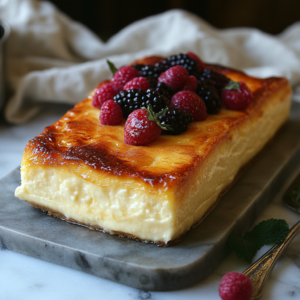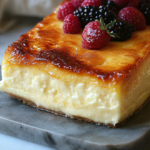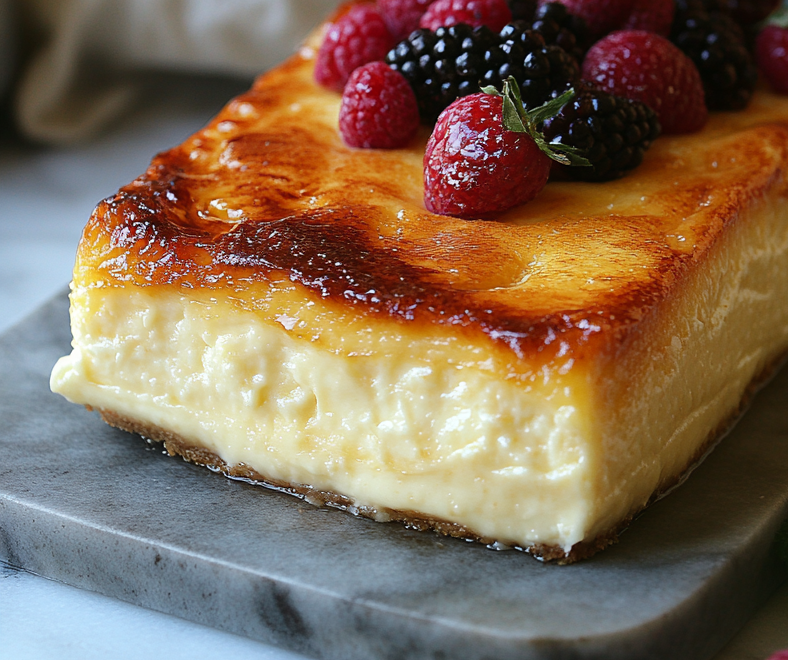Discover the secret to creating that signature caramelized top and silky interior with this foolproof loaf pan method that’s perfect for home bakers.The Loaf Pan Basque Cheesecake has revolutionized how we think about cheesecake baking. This elegant dessert combines the rustic charm of traditional Basque burnt cheesecake with the practical convenience of loaf pan baking, creating portions that are both beautiful and perfectly sized for sharing.
Unlike traditional New York-style cheesecakes that require water baths and precise temperature control, the Loaf Pan Basque Cheesecake embraces high heat and intentional caramelization. The result is a dessert with a gorgeously burnished top that gives way to an impossibly creamy, almost custard-like interior that melts on your tongue.
For experienced home bakers and cooking enthusiasts who appreciate both simplicity and sophistication, this cheesecake represents the perfect balance of technique and accessibility. It’s a dessert that looks impressive on any dinner table while being surprisingly forgiving to make.
Why the Loaf Pan Basque Cheesecake Has Become a Baking Sensation
The appeal of Loaf Pan Basque Cheesecake lies in its beautiful contradiction: it looks rustic and effortless, yet delivers restaurant-quality results. The signature burnt top isn’t a flaw to avoid—it’s the hallmark of this Spanish-inspired dessert that adds depth of flavor and visual drama.
The loaf pan format offers distinct advantages over traditional round cheesecakes. The rectangular shape creates elegant, clean slices that plate beautifully, while the smaller format makes it perfect for intimate dinner parties or family gatherings. The deeper sides of a loaf pan also help achieve that characteristic tall profile that makes each slice so visually appealing.
Many bakers discover that the Loaf Pan Basque Cheesecake is more forgiving than other cheesecake varieties. There’s no crust to crack, no water bath to manage, and the high-heat method actually encourages the browning that makes this dessert so distinctive.
Understanding the Art of Basque Cheesecake Making
The Science Behind the Perfect Burn
Creating the ideal Loaf Pan Basque Cheesecake is as much about understanding the science as following the recipe. The high baking temperature—typically 400°F or higher—causes the proteins in the cream cheese and eggs to set quickly, creating a firm exterior while keeping the center luxuriously soft.
The caramelization process that creates that stunning top layer occurs when the natural sugars in the cream cheese and added sugar reach temperatures that promote the Maillard reaction. This isn’t burning in the traditional sense; it’s controlled caramelization that adds complex flavors reminiscent of caramel and butterscotch.
Ingredient Quality Makes the Difference
The simplicity of Loaf Pan Basque Cheesecake means that ingredient quality is paramount. Full-fat cream cheese at room temperature creates the smoothest texture, while fresh, high-quality eggs contribute to both richness and proper setting. Using real vanilla extract rather than artificial flavoring makes a noticeable difference in the final flavor profile.
Many experienced bakers recommend using European-style butter when the recipe calls for it, as the higher fat content contributes to the cake’s luxurious mouthfeel. The type of sugar used can also affect the final result—superfine sugar dissolves more easily and creates a smoother texture than regular granulated sugar.
The Original Loaf Pan Basque Cheesecake Recipe
This carefully developed recipe creates the perfect balance of caramelized exterior and creamy interior that defines an exceptional Basque cheesecake.
Essential Ingredients
For the Cheesecake:
- 2 lbs (32 oz) full-fat cream cheese, room temperature
- 1¼ cups granulated sugar
- 6 large eggs, room temperature
- 2 cups heavy cream
- ⅓ cup all-purpose flour
- 1 teaspoon vanilla extract
- ½ teaspoon salt
- 2 tablespoons butter for greasing
For Serving (Optional):
- Fresh berries (raspberries, blackberries, strawberries)
- Powdered sugar for dusting
- Fresh mint leaves
- Berry coulis or jam

Step-by-Step Instructions
Preparing Your Loaf Pan:
Preheat your oven to 425°F and position a rack in the center. Generously butter a 9×5-inch loaf pan, paying special attention to the corners and edges. Line the pan with parchment paper, allowing it to overhang the sides by about 2 inches for easy removal.
The parchment paper is crucial for both easy removal and achieving the characteristic rustic appearance. Don’t worry about making it perfect—the wrinkles and folds actually add to the authentic Basque cheesecake aesthetic.
Creating the Perfect Batter:
Beat the room-temperature cream cheese in a large bowl until completely smooth and lump-free, about 3-4 minutes. This step is critical—any lumps at this stage will remain in the finished cake. Gradually add the sugar, beating until well incorporated.
Add eggs one at a time, beating well after each addition. The mixture should be smooth and glossy. Slowly pour in the heavy cream while mixing on low speed, then add the flour, vanilla extract, and salt. Mix just until combined—overmixing can incorporate too much air.
The High-Heat Baking Method:
Pour the batter into your prepared loaf pan, filling it about three-quarters full. The batter should be smooth and free of air bubbles. Tap the pan gently on the counter to release any trapped air.
Bake for 50-60 minutes, until the top is deeply golden brown and appears set but still slightly jiggly in the center. The Loaf Pan Basque Cheesecake is done when the top has achieved that signature dark caramelization and the center springs back lightly when touched.
Cooling and Setting:
Allow the cheesecake to cool completely in the pan before attempting to remove it. This process takes several hours and is crucial for proper texture development. The cheesecake will continue to set as it cools, and the flavors will meld and intensify.
Once cooled, use the parchment paper overhangs to carefully lift the cheesecake from the pan. The finished Loaf Pan Basque Cheesecake should have a beautifully caramelized top with a creamy, almost custard-like interior.
Professional Tips for Basque Cheesecake Success
Temperature Control and Timing
The key to a perfect Loaf Pan Basque Cheesecake lies in understanding your oven’s behavior. Every oven runs slightly differently, so the first time you make this recipe, check the cheesecake after 45 minutes. You’re looking for a deep golden-brown top with just a slight jiggle in the center.
Room temperature ingredients are non-negotiable for smooth mixing and even baking. Take your cream cheese and eggs out of the refrigerator at least 2-3 hours before baking, or use the quick-softening method of placing sealed cream cheese packages in warm water for 30 minutes.
Achieving the Perfect Texture
The hallmark of an exceptional Loaf Pan Basque Cheesecake is its contrast of textures—the slightly firm, caramelized exterior giving way to an almost molten center. This texture develops through the combination of high heat and careful timing.
Don’t be alarmed if the cheesecake appears to puff dramatically during baking, then deflate as it cools. This is completely normal and contributes to the rustic appearance that makes Basque cheesecake so appealing.
Storage and Serving Recommendations
A properly made Loaf Pan Basque Cheesecake actually improves with time. Wrap it carefully and refrigerate for at least 4 hours, or preferably overnight, before serving. The flavors continue to develop and the texture becomes even more luxurious.
For serving, use a sharp knife wiped clean between cuts to achieve those beautiful, clean slices. The cheesecake can be served chilled or at room temperature, depending on your preference. Many find that allowing it to sit at room temperature for 20-30 minutes before serving enhances the creamy texture.
Creative Variations and Flavor Enhancements
Fruit and Berry Combinations
The neutral canvas of Loaf Pan Basque Cheesecake pairs beautifully with fresh seasonal fruits. The classic combination of mixed berries—raspberries, blackberries, and strawberries—provides both visual appeal and a tartness that balances the rich, sweet cheesecake.
For a more sophisticated presentation, consider macerating berries with a touch of sugar and lemon juice before serving. This creates a natural syrup that complements the caramelized flavors of the cheesecake while adding bright acidity.
Flavor Infusions and Add-ins
While traditional Loaf Pan Basque Cheesecake relies on vanilla for flavoring, subtle variations can create entirely new taste experiences. A tablespoon of quality rum or brandy adds depth without overwhelming the base flavors. Lemon zest brightens the entire dessert while maintaining its elegant simplicity.
For chocolate lovers, a swirl of melted dark chocolate through the batter before baking creates beautiful marbled patterns and adds complexity. Coffee extract or espresso powder can transform the cheesecake into a sophisticated dessert perfect for dinner parties.
Troubleshooting Common Basque Cheesecake Challenges
Preventing Cracks and Achieving Even Browning
Unlike traditional cheesecakes where cracks are avoided, Loaf Pan Basque Cheesecake embraces a more rustic appearance. However, if you prefer a smoother top, ensure your ingredients are properly at room temperature and avoid overmixing the batter.
Uneven browning can usually be traced to oven hot spots or incorrect rack positioning. Using the center rack and rotating the pan halfway through baking often resolves these issues. If your oven runs hot, reduce the temperature by 25°F and extend the baking time slightly.
Texture Troubleshooting
If your Loaf Pan Basque Cheesecake turns out too dense, the most likely culprit is overmixed batter or ingredients that weren’t at room temperature. Cold cream cheese doesn’t incorporate smoothly, leading to a dense final texture regardless of mixing technique.
Conversely, if the cheesecake seems too loose or doesn’t set properly, it may not have baked long enough. The center should be just set but still slightly jiggly when the cake is done. It will continue to firm up during cooling.
The Art of Presentation and Serving
Creating Restaurant-Quality Plating
The beauty of Loaf Pan Basque Cheesecake lies partly in its rustic charm, but thoughtful presentation elevates it from homemade dessert to restaurant-quality finale. Clean, precise slices are essential—use a sharp knife dipped in warm water and wiped clean between cuts.
Consider the color contrast when plating. The golden-brown cheesecake looks stunning against white plates, while the addition of colorful berries creates visual interest and appetite appeal. A light dusting of powdered sugar just before serving adds an elegant finishing touch.
Seasonal Serving Suggestions
The versatility of Loaf Pan Basque Cheesecake makes it suitable for year-round entertaining. In summer, pair it with fresh berries and a light berry coulis. Fall calls for caramelized pear slices or a drizzle of maple syrup. Winter presentations might include candied citrus peel or a warm fruit compote.
The key to successful seasonal variations is maintaining balance. The cheesecake itself is rich and satisfying, so accompaniments should provide contrast in either flavor, texture, or temperature.
Creating Memorable Moments with Basque Cheesecake
Building Confidence Through Practice
Mastering the Loaf Pan Basque Cheesecake is a journey that rewards patience and practice. Each attempt teaches something new about your oven’s behavior, ingredient interaction, and timing. Keep detailed notes about what works in your kitchen, as these insights become invaluable for consistent results.
Many experienced bakers find that making this cheesecake becomes a meditative process. The simple ingredient list and straightforward technique allow focus on the subtleties that separate good cheesecake from exceptional cheesecake.
Sharing the Experience
Food has the remarkable ability to create connections and memories, and the Loaf Pan Basque Cheesecake exemplifies this beautifully. Its impressive appearance and sophisticated flavors make it perfect for special occasions, while its approachable technique makes it suitable for regular family desserts.
Consider involving family members or friends in the process. The simple mixing technique makes it an ideal recipe for sharing knowledge and creating together. Many find that the anticipation during the long cooling period becomes part of the experience, building excitement for that first perfect slice.
Your Journey to Basque Cheesecake Mastery
The path to creating exceptional Loaf Pan Basque Cheesecake combines technique with intuition, precision with creativity. Each cheesecake you make will be slightly different, influenced by factors like humidity, oven variations, and ingredient temperatures. This variability isn’t a flaw—it’s part of the charm that makes homemade desserts so special.
Embrace the learning process and don’t be discouraged if your first attempt isn’t perfect. Even professional pastry chefs consider each cheesecake a learning opportunity. The joy lies not just in the final product, but in the process of creation and the pleasure it brings to those who share it with you.
Whether you’re expanding your baking repertoire or rediscovering the joy of creating something beautiful from simple ingredients, the Loaf Pan Basque Cheesecake offers a perfect balance of challenge and reward. Its timeless appeal ensures that your efforts will be met with appreciation and requests for the recipe from everyone fortunate enough to taste your creation.
Take your time, trust the process, and prepare to be delighted by the magic that happens when simple ingredients are transformed into something truly extraordinary through the alchemy of careful baking.
Print
Perfect Loaf Pan Basque Cheesecake
Description
The Loaf Pan Basque Cheesecake has revolutionized how we think about cheesecake baking. This elegant dessert combines the rustic charm of traditional Basque burnt cheesecake with the practical convenience of loaf pan baking, creating portions that are both beautiful and perfectly sized for sharing.
Ingredients
For the Cheesecake:
- 2 lbs (32 oz) full-fat cream cheese, room temperature
- 1¼ cups granulated sugar
- 6 large eggs, room temperature
- 2 cups heavy cream
- ⅓ cup all-purpose flour
- 1 teaspoon vanilla extract
- ½ teaspoon salt
- 2 tablespoons butter for greasing
For Serving (Optional):
- Fresh berries (raspberries, blackberries, strawberries)
- Powdered sugar for dusting
- Fresh mint leaves
- Berry coulis or jam
Instructions
Preparing Your Loaf Pan:
Preheat your oven to 425°F and position a rack in the center. Generously butter a 9×5-inch loaf pan, paying special attention to the corners and edges. Line the pan with parchment paper, allowing it to overhang the sides by about 2 inches for easy removal.
The parchment paper is crucial for both easy removal and achieving the characteristic rustic appearance. Don’t worry about making it perfect—the wrinkles and folds actually add to the authentic Basque cheesecake aesthetic.
Creating the Perfect Batter:
Beat the room-temperature cream cheese in a large bowl until completely smooth and lump-free, about 3-4 minutes. This step is critical—any lumps at this stage will remain in the finished cake. Gradually add the sugar, beating until well incorporated.
Add eggs one at a time, beating well after each addition. The mixture should be smooth and glossy. Slowly pour in the heavy cream while mixing on low speed, then add the flour, vanilla extract, and salt. Mix just until combined—overmixing can incorporate too much air.
The High-Heat Baking Method:
Pour the batter into your prepared loaf pan, filling it about three-quarters full. The batter should be smooth and free of air bubbles. Tap the pan gently on the counter to release any trapped air.
Bake for 50-60 minutes, until the top is deeply golden brown and appears set but still slightly jiggly in the center. The Loaf Pan Basque Cheesecake is done when the top has achieved that signature dark caramelization and the center springs back lightly when touched.
Cooling and Setting:
Allow the cheesecake to cool completely in the pan before attempting to remove it. This process takes several hours and is crucial for proper texture development. The cheesecake will continue to set as it cools, and the flavors will meld and intensify.
Once cooled, use the parchment paper overhangs to carefully lift the cheesecake from the pan. The finished Loaf Pan Basque Cheesecake should have a beautifully caramelized top with a creamy, almost custard-like interior.
